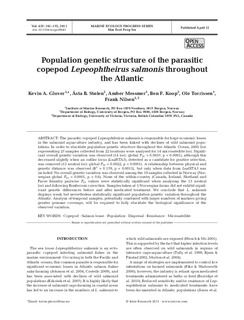Population genetic structure of the parasitic copepod Lepeophtheirus salmonis throughout the Atlantic
Journal article, Peer reviewed

Permanent lenke
http://hdl.handle.net/11250/108617Utgivelsesdato
2011-04-12Metadata
Vis full innførselSamlinger
- Articles [3012]
Originalversjon
http://dx.doi.org/10.3354/meps09045Sammendrag
The parasitic copepod Lepeophtheirus salmonis is responsible for huge economic losses in the salmonid aquaculture industry, and has been linked with declines of wild salmonid populations. In order to elucidate population genetic structure throughout the Atlantic Ocean, 2495 lice representing 27 samples collected from 22 locations were analysed for 14 microsatellite loci. Significant overall genetic variation was observed (14 loci: global FST = 0.0057, p < 0.0001), although this decreased slightly when an outlier locus (LsalSTA3), detected as a candidate for positive selection, was removed (13 neutral loci: global FST = 0.0022, p < 0.0001). A relationship between physical and genetic distance was observed (R2 = 0.179, p = 0.0013), but only when data from LsalSTA3 was included. No overall genetic variation was observed among the 19 samples collected in Norway (Norwegian global FST < 0.0001, p = 0.6). None of the within-country (Canada, Ireland, Shetland and Faroe Islands) pairwise FST values were statistically significant when analysing the 13 neutral loci and following Bonferroni correction. Samples taken at 5 Norwegian farms did not exhibit significant genetic differences before and after medicated treatment. We conclude that L. salmonis displays weak but nevertheless statistically significant population genetic variation throughout the Atlantic. Analysis of temporal samples, potentially combined with larger numbers of markers giving greater genome coverage, will be required to fully elucidate the biological significance of the observed variation.